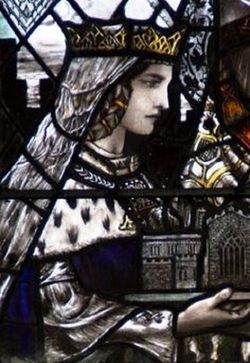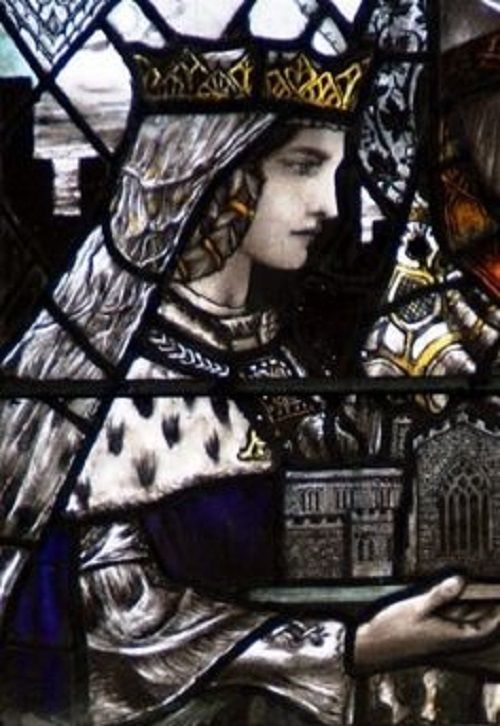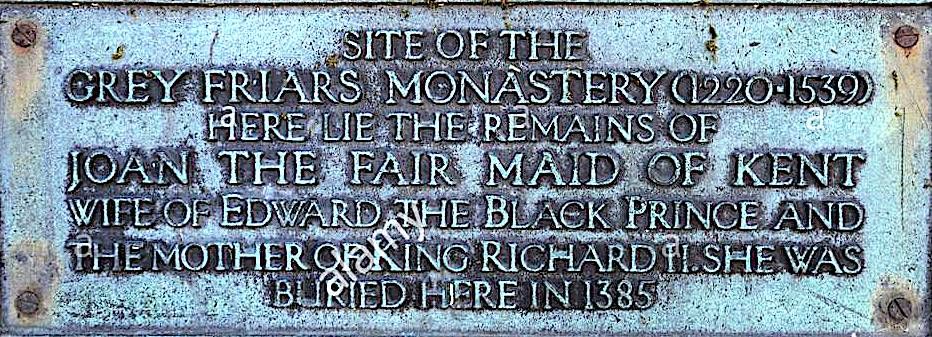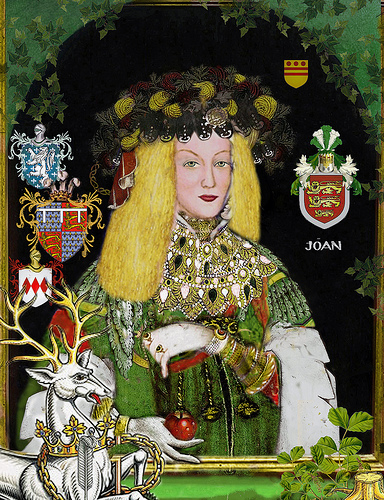Joan of Kent was born in 1328 to Edmund of Woodstock Plantagenet, 1st Earl of Kent, son of King Edward I of England, and Margaret Wake, 3rd Baroness Wake of Liddell. She was the third of four children. Her father, the Earl of Kent, was executed for political reasons when Joan was only a toddler. Her cousin, King Edward III, took responsibility for the family, and brought them to live at the royal court with him.
When Joan was twelve years old, she fell in love with a soldier named Thomas Holland. They married in secret, without the approval of Joan's parents. However, that same year, Thomas was sent overseas to fight in the Hundred Years' War, and that winter, Joan's parents married her to William Montague, son of the 1st Earl of Salisbury. Joan did not disclose her previous marriage to Thomas because she feared that he would be executed for treason.
Several years later, Thomas returned to England and discovered that his wife had been married to another man. Now, Thomas confessed his secret marriage to Joan in the hopes that her marriage to Montague would be declared invalid. When Montague discovered that Joan supported Thomas's case, he became very angry and locked Joan in their home as a prisoner. The marriage between Joan and Montague was eventually annulled in 1349, when Joan was twenty-one. Joan then went to live with Thomas, and the happily reunited couple had several children before Thomas's death in 1360.
Their children were: Thomas Holland, 2nd Earl of Kent, born 1350; John Holland, 1st Duke of Exeter, born circa 1352; Joan Holland, born 1356, who married John V, Duke of Brittany; and Maud Holland, born 1359, who married Waleran III of Luxembourg, Count of Ligny. Some sources also list a fifth child, Edmund Holland, born 1354, who died young.
Joan inherited the titles of Countess of Kent and Lady Wake of Liddell in 1352 with the death of the last of her siblings.
Joan's second marriage in 1351 was to her first cousin once removed, Edward the Black Prince, the eldest son of King Edward III. Though their marriage would have been forbidden because they were closely related, Pope Innocent VI intervened and granted a dispensation which allowed the couple to be married.
When Edward was invested Prince of Aquitaine, the couple moved to France, where they had their two children, Edward, born 1365, and Richard, born 1367.
She requested in her will she be buried with her first husband, Sir Thomas, at Greyfriars Church, which is now the site of a hospital. ~ Bio by Charlotte, #47579980
During her lifetime, she amassed a number of titles including: 1st Princess of Wales, 4th Countess of Kent , and 5th Baroness Wake of Liddell.
A quote from her last will and testament:
"In the year of our Lord 1385, and of the reign of my dear son Richard, King of England and France; at my Castle of Walyngford, in the Diocese of Salisbury, the 7th of August, I Joan Princess of Wales, Duchess of Cornwall, Countess of Chester, and Lady Wake. . .
. . .My body to be buried in my chapel at Stanford, near the monument of our late lord and husband, the Earl of Kent. . .
To my dear son the King, my new bed of red velvet, embroidered with ostrich feathers of silver, and heads of leopards of gold with boughs and leaves issuing out of their mouths. To my dear son Thomas Earl of Kent, my bed of red camak [sic.] paled with red and rays of gold. To my dear son John Holland, a bed of red camak. . .
. . .And I appoint the Venerable Father in Christ, my dear friend and cousin, Robert Bishop of London; William Bishop of Winchester; John Lord Cobham; William de Beauchamp, William de Nevill, Simon de Burlee, Lewis Clifford, Richard Atterbury, John Clanvow, Richard Stury, John Worthe, steward of my lands, and John le Vache, Knights; together with my dear chaplains, William de Fulburn and John de Yernemouth; and my loving esquires, William de Harpele, and William Norton, my executors. Witnessed by the Prior of Walyngforde and John James."
Joan of Kent was born in 1328 to Edmund of Woodstock Plantagenet, 1st Earl of Kent, son of King Edward I of England, and Margaret Wake, 3rd Baroness Wake of Liddell. She was the third of four children. Her father, the Earl of Kent, was executed for political reasons when Joan was only a toddler. Her cousin, King Edward III, took responsibility for the family, and brought them to live at the royal court with him.
When Joan was twelve years old, she fell in love with a soldier named Thomas Holland. They married in secret, without the approval of Joan's parents. However, that same year, Thomas was sent overseas to fight in the Hundred Years' War, and that winter, Joan's parents married her to William Montague, son of the 1st Earl of Salisbury. Joan did not disclose her previous marriage to Thomas because she feared that he would be executed for treason.
Several years later, Thomas returned to England and discovered that his wife had been married to another man. Now, Thomas confessed his secret marriage to Joan in the hopes that her marriage to Montague would be declared invalid. When Montague discovered that Joan supported Thomas's case, he became very angry and locked Joan in their home as a prisoner. The marriage between Joan and Montague was eventually annulled in 1349, when Joan was twenty-one. Joan then went to live with Thomas, and the happily reunited couple had several children before Thomas's death in 1360.
Their children were: Thomas Holland, 2nd Earl of Kent, born 1350; John Holland, 1st Duke of Exeter, born circa 1352; Joan Holland, born 1356, who married John V, Duke of Brittany; and Maud Holland, born 1359, who married Waleran III of Luxembourg, Count of Ligny. Some sources also list a fifth child, Edmund Holland, born 1354, who died young.
Joan inherited the titles of Countess of Kent and Lady Wake of Liddell in 1352 with the death of the last of her siblings.
Joan's second marriage in 1351 was to her first cousin once removed, Edward the Black Prince, the eldest son of King Edward III. Though their marriage would have been forbidden because they were closely related, Pope Innocent VI intervened and granted a dispensation which allowed the couple to be married.
When Edward was invested Prince of Aquitaine, the couple moved to France, where they had their two children, Edward, born 1365, and Richard, born 1367.
She requested in her will she be buried with her first husband, Sir Thomas, at Greyfriars Church, which is now the site of a hospital. ~ Bio by Charlotte, #47579980
During her lifetime, she amassed a number of titles including: 1st Princess of Wales, 4th Countess of Kent , and 5th Baroness Wake of Liddell.
A quote from her last will and testament:
"In the year of our Lord 1385, and of the reign of my dear son Richard, King of England and France; at my Castle of Walyngford, in the Diocese of Salisbury, the 7th of August, I Joan Princess of Wales, Duchess of Cornwall, Countess of Chester, and Lady Wake. . .
. . .My body to be buried in my chapel at Stanford, near the monument of our late lord and husband, the Earl of Kent. . .
To my dear son the King, my new bed of red velvet, embroidered with ostrich feathers of silver, and heads of leopards of gold with boughs and leaves issuing out of their mouths. To my dear son Thomas Earl of Kent, my bed of red camak [sic.] paled with red and rays of gold. To my dear son John Holland, a bed of red camak. . .
. . .And I appoint the Venerable Father in Christ, my dear friend and cousin, Robert Bishop of London; William Bishop of Winchester; John Lord Cobham; William de Beauchamp, William de Nevill, Simon de Burlee, Lewis Clifford, Richard Atterbury, John Clanvow, Richard Stury, John Worthe, steward of my lands, and John le Vache, Knights; together with my dear chaplains, William de Fulburn and John de Yernemouth; and my loving esquires, William de Harpele, and William Norton, my executors. Witnessed by the Prior of Walyngforde and John James."
Family Members
See more Holland Montacute Plantagenet or Plantagenet memorials in:
- Greyfriars Holland Montacute Plantagenet or Plantagenet
- Stamford Holland Montacute Plantagenet or Plantagenet
- South Kesteven District Holland Montacute Plantagenet or Plantagenet
- Lincolnshire Holland Montacute Plantagenet or Plantagenet
- England Holland Montacute Plantagenet or Plantagenet
- Find a Grave Holland Montacute Plantagenet or Plantagenet














